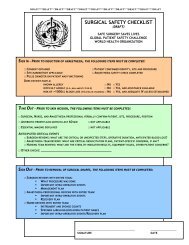The Essentials of Patient Safety - Clinical Human Factors Group
The Essentials of Patient Safety - Clinical Human Factors Group
The Essentials of Patient Safety - Clinical Human Factors Group
You also want an ePaper? Increase the reach of your titles
YUMPU automatically turns print PDFs into web optimized ePapers that Google loves.
<strong>The</strong> <strong>Essentials</strong> <strong>of</strong> <strong>Patient</strong> <strong>Safety</strong><br />
KEY POINTS<br />
<strong>Patient</strong>s and families can provide critical safety information and play a part in<br />
monitoring the safety <strong>of</strong> their own care<br />
Expert clinicians learn to work confidently yet safely, by anticipating and negotiating<br />
the hazards <strong>of</strong> both the disease and the organisation.<br />
A team that is working poorly multiplies the possibility <strong>of</strong> error. Teams that work<br />
well are safer than any one individual.<br />
Explicit daily plans and goals can enormously increase reliability <strong>of</strong> care providing to<br />
patients<br />
Using briefing and checklists in the operating theatre reduces surgical complications<br />
and improves team performance<br />
References<br />
1. Berwick DM. Escape Fire. Designs for the future <strong>of</strong> healthcare. San<br />
Francisco: Jossey Bass; 2003.<br />
2. Weingart SS. What Can Hospitalized <strong>Patient</strong>s Tell Us About Adverse Events<br />
Learning from <strong>Patient</strong>-Reported Incidents. Journal <strong>of</strong> General Internal Medicine,<br />
2005;20(9):830.<br />
3. Weissman JS, Schneider EC, Weingart SN, Epstein AM, David-Kasdan J,<br />
Feibelmann S, et al. Comparing <strong>Patient</strong>-Reported Hospital Adverse Events with<br />
Medical Record Review: Do <strong>Patient</strong>s Know Something That Hospitals Do Not<br />
Annals <strong>of</strong> Internal Medicine, 2008;149(2):100-8.<br />
4. Coulter A, Ellins J. Effectiveness <strong>of</strong> strategies for informing, educating, and<br />
involving patients. British Medical Journal, 2007;335(7609):24-7.<br />
5. Davis RE, Koutantji M, Vincent CA. How willing are patients to question<br />
healthcare staff on issues related to the quality and safety <strong>of</strong> their healthcare An<br />
exploratory study. Quality and <strong>Safety</strong> in Health Care, 2008;17(2):90-6.<br />
6. Waterman AD, Gallagher TH, Garbutt J, Waterman BM, Fraser V, Burroughs<br />
TE. Brief report: Hospitalized patients' attitudes about and participation in error<br />
prevention. Journal General Internal Medicine, 2006;21(4):367-70.<br />
7. McGuckin M, Taylor A, Martin V, Porten L, Salcido R. Evaluation <strong>of</strong> a<br />
patient education model for increasing hand hygiene compliance in an inpatient<br />
rehabilitation unit. American Journal Infection Control, 2004;32(4):235-8.<br />
8. Long S, Arora S, Moorthy K, Sevdalis N, Vincent C. Qualities and attributes<br />
<strong>of</strong> a safe practitioner: identification <strong>of</strong> safety skills in healthcare. BMJ Quality &<br />
<strong>Safety</strong>, 2011 (6):483-90.<br />
9. Dominguez C, Flach JM, McDermott PC, McKellar DM, Dunn M. <strong>The</strong><br />
conversion decision in laparoscopic surgery: Knowing your limits and limiting your<br />
risks. In: Smith K, Shanteau J, Johnson P, editors. Psychological investigations <strong>of</strong><br />
competence in decision making. Cambridge: Cambridge University Press; 2004. p. 7-<br />
39.<br />
34








